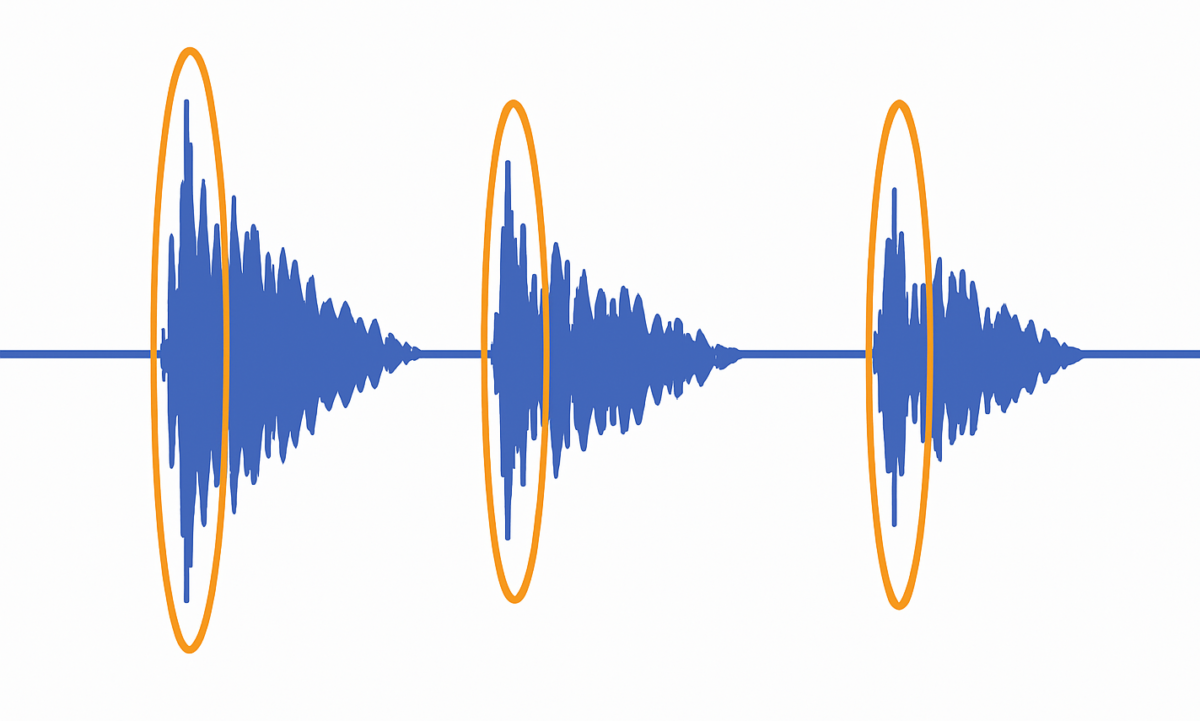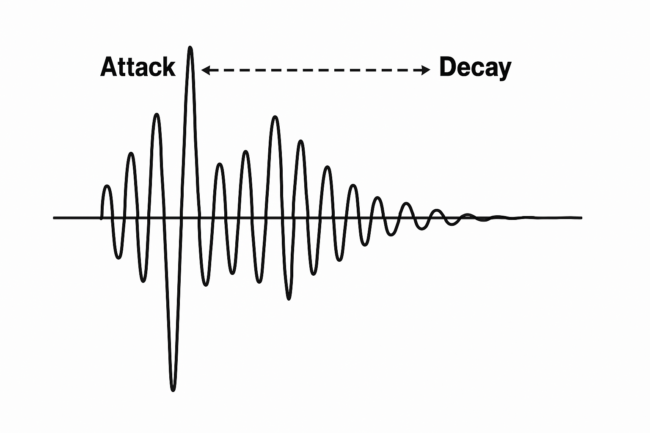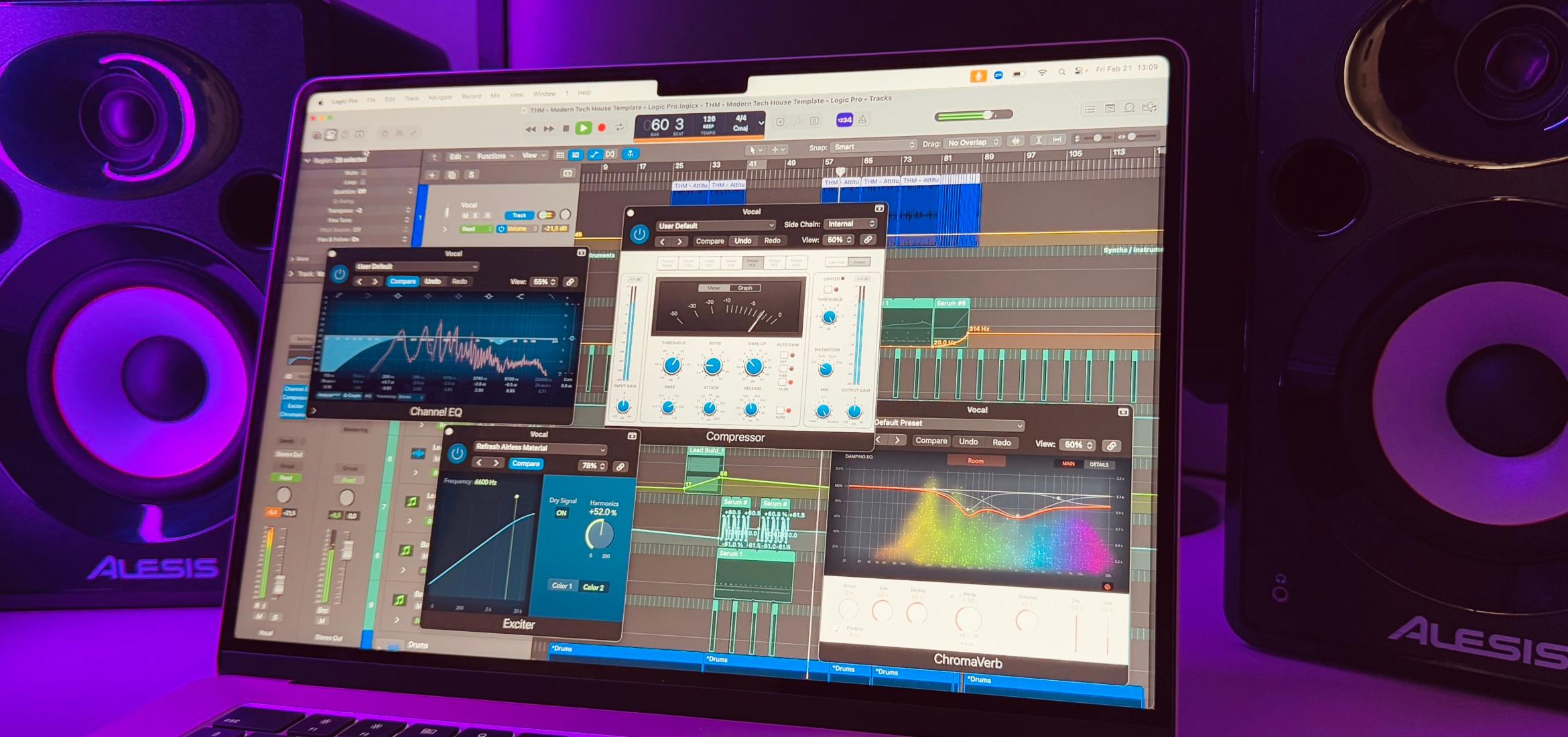Transients are the fast bursts of energy at the very start of a sound. They jump out suddenly and fade in a blink. They often define how punchy or snappy a sound is. Many producers overlook them at first, yet these tiny peaks influence how a track feels.
They shape our perception of clarity and impact. When a drumstick hits a snare, the first crack is a prime example. This defining moment tells us the hit is forceful or relaxed. That energy guides our ears toward the music’s motion and tone.
This article explores transients music production. It outlines how they work, where they appear, and how to shape them. It also explains how different genres approach them. You will find practical tips for skill levels ranging from beginner to advanced. By the end, you should feel confident using transients in audio to create more compelling, dynamic mixes.
Keep an open mind and experiment with the concepts shared here. Remember that every sound has a beginning. How you sculpt that beginning can transform your music. Whether you want aggressive drums or a soft, ambient texture, transients play a major role.
Table of Contents
- What are Transients in Audio?
- Key Instrument Examples
- Why Transients Matter
- Transients in Sound Design
- Shaping Transients
- Transients in Audio Across Different Genres
- Advanced Concepts
- Tips for Different Skill Levels
- Conclusion
What are Transients in Audio?
A transient is the tiny spark at a sound’s onset. It is the part that occurs right when you strike a key, pick a string, or hit a drum. Think about a word: if the word is “Tap,” the consonant “T” is the transient. The following vowel carries the main tone.

These bursts often last only a few milliseconds. Yet they set the tone for the rest of the sound’s envelope. If you look at a waveform, the transient is that steep jump near the start. It is usually the loudest part, reaching a brief peak.
Many producers view transients in audio as the attack or accent. That intense peak can define how a sound is identified. You hear a quick smack of a snare, and your brain instantly recognizes “drum.” If the peak is absent, the sound loses clarity and feels dull.
Real-World Examples
The pillow vs. snare analogy helps clarify how transients feel. A pillow produces a muffled thud with little definition. A snare emits a sharp crack that awakens the ears. The pillow lacks a quick burst, while the snare bursts violently at the start.
Another example is the “click” in a kick drum. It emerges from the moment the beater strikes. Without it, the kick can sound mushy. With it, the kick becomes distinct and stands out in a mix.
Even a vocal has transients when plosives or consonants appear. The sudden “T” or “P” can pop out of the overall vocal line. These small peaks are essential for intelligibility and add presence. Recognizing them is the first step toward shaping them.
Key Instrument Examples
This section explores how different instruments present transients. Each instrument has a unique character in its initial spike. This is crucial for understanding how to enhance or tame their attacks.
Kick Drums
Kicks usually feature a quick thump or click at the start. That click is where higher frequencies cluster. It helps the kick cut through crowded mixes. The low-frequency body follows this peak. By boosting the attack or “punch,” a dull kick can become more powerful.
A strong transient in a kick drum is often key for electronic genres. It provides an immediate sense of impact. This impact drives energy on the dance floor. Without it, the kick might blend into the bass and lose definition.
Snare Drums
Snares have a sharp crack that delivers the main punch. That crack is the transient. It stands out because of the bright, noisy content produced by the wires on the bottom head. After the transient, the snare resonates in the body.
The snare’s crack can be enhanced with layering or by using a transient shaper. When the transient is strong, the snare feels tight and snappy. If overcompressed, it might lose its defining edge and sound dull.

Hi-Hats and Cymbals
Hi-hats and cymbals rely on a bright chick or ping for the initial transient. This short peak is often found in the high-frequency range. Removing it turns a hi-hat into a wash of metallic sound. Keeping it intact preserves the crisp timing that hi-hats provide.
Open cymbals or crash hits also have a quick strike. After that, the shimmer and wash follow. The initial transient separates the crash from the sustaining swirl of sound. Too much emphasis might make them harsh. Too little robs them of presence.
Vocals
Vocal transients emerge in consonant sounds. Plosives like “p” and “b” can create strong peaks. Sibilants like “t” or “s” can also act like mini transients. They help words enunciate. They also require control to avoid unpleasant pops.
A well-managed vocal transient keeps the vocal lively but not jarring. Overly loud consonants might cut the listener’s ears. Balancing these elements ensures clarity. A subtle pop filter or compression technique can help tame sudden peaks.
Why Transients Matter
Transients in audio have a major impact on how a track feels. This section covers the reasons behind their importance. It also explores how they relate to headroom and overall dynamics.
Groove and Power
Music with defined transients sounds more energetic. The punch in a kick or the snap of a snare drives a beat forward. That feeling can be the difference between a track that makes you move and one that falls flat.
Transients help direct attention to certain elements. When a transient stands out, it cues our ears to focus. This can boost a song’s groove and engagement. It can also shape a listener’s emotional response to the track.
Clarity and Definition
Transients slice through a mix by their fast, bright nature. They help us pinpoint the start of each note. Without clear transients, multiple sounds can blur together. The result is a muddy soundscape that lacks separation.
Clarity also helps with arrangement. A crisp attack on a guitar makes it distinct from the piano. Each part gets its own moment to shine. This sense of definition is critical in busy mixes, where elements compete for space.
Dynamics vs. Loudness
Transients typically reach the highest volume of a sound. They may dictate the peak level on a meter. If left unchecked, these peaks can reduce headroom. It might force the overall level down to avoid clipping.
Some producers soften transients to push volume higher. However, doing so can drain a track of its energy. Others preserve transients in audio for punch but risk lower overall loudness. Finding a balance is key. When transients are managed well, a track retains both impact and adequate loudness.
Transients in Sound Design
Transients are not only for mixing. They also shape the character of sounds in creative ways. This section explains how sound designers handle transients to produce dramatic hits or mellow textures.
Creating Impactful Hits
Sound designers often layer a short snap at the start. This snap becomes the transient, while the sustain carries the body. In a cinematic impact, a high-frequency click adds punch, while low booms support depth.

By isolating the transient layer, designers can fine-tune it separately. This approach is common for designing signature drums or effects. A single strong attack can elevate the perceived intensity of a sample.
Softening for Mood
Ambient or chill styles often seek a gentle, floating atmosphere. Hard transients can disrupt that vibe. Designers remove or reduce them with slow attack envelopes. The result is a slow swell instead of a quick strike.
This method transforms sharp percussion into soft pulses. The listener experiences a gradual rise in volume. It creates a dreamy ambiance free of harsh peaks.
Envelope Shaping in Synthesis
When using a synth’s ADSR, the Attack parameter directly affects the transient. A zero attack time yields an immediate spike. A longer attack reduces or eliminates that initial burst. Filter envelopes also add color to the transient area.
A quick filter envelope can generate a bright flash at the start of a note. That tiny spike stands out as a transient-like effect. This is often used in plucked or punchy bass sounds to enhance their initial bite.
Layering Textures
Transients in audio define a sample’s attitude. Some producers combine a clap’s transient with a snap or a typewriter click. This unique blend reinvents a familiar drum sound. Foley artists also do this for punch effects in films.
By swapping transient layers, you can create new, hybrid sounds. This technique breathes fresh life into standard samples. It can make a dull snare stand out through an unexpected initial click or crack.
Shaping Transients
Producers rely on specific tools and strategies to control transients in audio. Shaping transients helps bring out their best qualities. It also prevents them from overwhelming a mix.
Transient Shaper Plugins
These plugins simplify attack and sustain adjustments. They detect the transient portion of a waveform and amplify or reduce it. They avoid the complex approach of using multiple processors.
Transient shapers are often used on drums. Boosting the attack on a kick can give more click. Reducing it can soften a harsh snare. They are usually quite transparent, resulting in fewer artifacts than compression.
Compression
A compressor can reduce or accentuate transients in audio, depending on the attack time. A fast attack will clamp down early. It reduces the transient, smoothing out the spike. A slow attack lets the transient pass before applying gain reduction. This retains a sharper punch.

Parallel compression involves blending a heavily squashed track with the original signal. The original transients remain while the compressed portion adds body. This technique can provide power without sacrificing clarity.
Volume Automation and Editing
Manual shaping can be done by cutting or fading specific peaks in the waveform. This offers precise control of each transient. It is time-consuming but effective for problematic hits.
Volume automation can highlight certain transients at specific moments. It can also fade them if they stick out too much. This is an alternative to heavy processing. It allows subtle adjustments without changing the entire track.
Envelopes (ADSR)
Synth or sampler envelopes let you tweak attack, decay, sustain, and release. A short attack time produces an immediate spike. A longer one mutes the onset. Similarly, a filter envelope can add a bright splash right at the note’s beginning.
Envelopes are especially useful for shaping MIDI-driven instruments. They let you define how each note starts, sustains, and ends. This approach is less destructive than editing audio clips.
Saturation and Clipping
Saturation adds harmonics and can gently compress peaks. It smooths transients by rounding them off. This can warm a snare that sounds too sharp or digital. Clipping, on the other hand, can emphasize transients in a more aggressive way.
Many producers push their drums into mild clipping. This ensures they pop through the mix while adding grit. Too much, though, can destroy the transient or create harsh distortion.
Other Techniques
Some producers use EQ to polish or tame harsh frequencies within a transient. Others apply noise gates to tighten a drum hit. Reverb pre-delay is also important. It lets the transient come through before reverb washes in. This preserves the initial clarity.
Shaping transients is not always about boosting them. Sometimes you need to reduce their sharpness to fit a track’s mood. The key is flexibility. Different material and styles need different approaches.
Transients in Audio Across Different Genres
Genres differ in how they treat transients. Some prefer bold spikes, while others favor gentle attacks. Tailoring transients in audio to your genre can make a track more authentic.
Hip-Hop and EDM
These styles thrive on heavy punch. The kick and snare often dominate with clear, defined attacks. Layering is a common approach. A sub-heavy kick pairs with a bright click. Trap snares combine a crisp transient with a rattling tail.
Sidechain compression is popular. It clears room for the kick’s transient by briefly ducking other elements. This ensures the transient shines through massive bass lines or busy synth lines. The result is a track that hits hard on big sound systems.
Rock
Rock relies on live drums, which generate bold transients. Compression and saturation are used to keep the hits aggressive but cohesive. Rock guitars, especially distorted ones, have reduced transients. The focus is on sustaining power chords.

Parallel compression on drums is common. It brings up the body while preserving the natural transient. This produces the energetic drive that rock music demands. A snare with a strong crack can propel a track forward, balancing with heavy guitars.
Ambient
Ambient and chill styles prefer soft or blurred transients. Hard spikes distract from the immersive soundscape. Pads and drones often have slower attacks, with gentle fades. Percussive elements might be softened or heavily reverberated.
Producers in these genres remove or lower transients intentionally. This creates a continuous flow without sharp edges. The music feels dreamy and evolves gradually. Maintaining a mellow onset is part of the core aesthetic.
Advanced Concepts
For those seeking deeper insight, these topics explore the technical side of transients. They delve into timing, spectral content, and psychoacoustic aspects.
Attack Time
Attack time can describe the natural onset of a sound or the parameter on a compressor. A fast natural attack means the sound reaches peak amplitude quickly. A bowed string has a slower attack, producing a gentler transient.

On a compressor, attack time controls how soon compression begins after signal crosses the threshold. A fast attack reduces the transient. A slow attack preserves it, making drums or plucks punch harder.
Envelope Shapes
Envelopes can be linear, exponential, or a blend. This shape determines how smoothly the sound’s amplitude ramps up. A linear attack increases volume in an even slope. An exponential attack increases it faster near the end of the envelope period.
In practice, an exponential attack can sound more natural. A linear attack might feel mechanical. Subtle envelope variations influence how musical or sharp a transient feels.
Spectral Content of Transients in Audio
Transients often occupy a broad frequency range. They can include a burst of high-frequency energy. That burst helps them stand out. A kick might have a distinct click around a certain range, while a snare might produce a bright snap higher up.

Understanding these frequency spikes can help you apply EQ more precisely. You can enhance or cut certain bands to shape the transient’s character. This approach is more surgical than simply boosting the entire attack.
Phase Alignment
Layered sounds must align in phase for a cohesive transient. If a kick sample is out of phase with another layer, they can cancel each other. This weakens the overall transient. Zooming in on waveforms can reveal subtle timing shifts.
Nudging a layer by a few milliseconds can fix phasing problems. This approach ensures the peaks line up at the same moment. The result is a powerful, combined transient instead of a flammed or hollow one.
Tips for Different Skill Levels
Producers at every stage can benefit from controlling transients in audio. This section suggests approaches for beginners, intermediate, and advanced practitioners.
Beginners
Beginners can start by learning to identify transients visually and by ear. Listening to a loop and spotting the sharp peaks is a good exercise. Basic compression with moderate attack times can gently tame or highlight those hits.
Using a simple transient shaper is often easier than fiddling with many knobs. A mild boost on the attack of a dull drum can teach you how transients alter punch. Always keep headroom when recording so transients do not clip.
Intermediate
Intermediate producers can layer sounds to refine transient and body balance. A short, high-pitched click can be layered on a boomy kick for greater definition. Sidechain compression is also powerful for making transients pop.
Transient-friendly EQ moves help carve space for crucial peaks. Dipping a frequency in a competing instrument can make a drum transient stand out. Referencing professional tracks is helpful. It guides you to recognize if your transients are too soft or too harsh.
Advanced
Advanced producers can automate transient shaper settings. They can adjust them at different sections for varied intensity. Micro-dynamics, such as emphasizing certain hi-hat hits, enrich the groove.

Mastering can also involve transient management. A limiter might suppress peaks too much, killing energy. Some limiters offer transient emphasis to counteract that effect. Phase alignment is essential for layered samples, especially in drum design.
Conclusion
Transients may only last a few milliseconds, yet they shape a track’s energy and clarity. From the initial snap of a drum to the subtle pop of a vocal consonant, transients in audio guide the ear and define character. Understanding how to shape them is vital for achieving dynamic, engaging mixes.
Producers often wrestle with the balance between preserving transients and achieving competitive loudness. Through tools like transient shapers, compression, and careful EQ, you can find an optimal middle ground. This middle ground retains the emotional impact that those initial spikes provide.
Different genres treat transients differently. Hip-hop and EDM need crisp hits. Rock focuses on raw, powerful drum attacks, while ambient music smooths them away. In each style, transients serve a creative purpose, whether intense and punchy or soft and inviting.
Beginners should practice spotting transients and using simple processing to get comfortable. Intermediate producers can delve deeper into layering and sidechain tactics. Advanced users can automate intricate micro-changes or manage transients in mastering.
With thoughtful transient shaping, your mixes will come alive. Each sound will feel more vibrant, and your listener’s ear will remain engaged. Remember that every note starts somewhere. Make that start count by sculpting the transients to convey the energy you envision.
Over de auteur

Néstor Rausell
Zanger, muzikant en specialist contentmarketingNéstor Rausell is de leadzanger van de rockband “Néstor Rausell y Los Impostores”. Bij MasteringBOX werkt hij als marketingexpert.
Laat een reactie achter
Log in om een reactie te plaatsen


